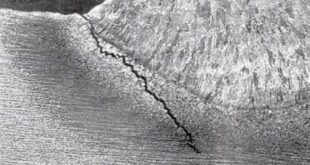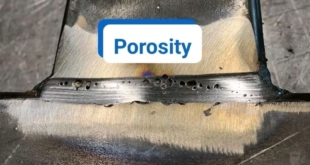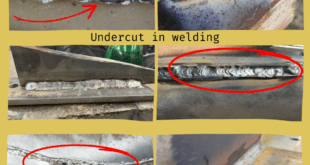Poor Shielding Gas Coverage in Welding
Proper Shielding gas coverage plays a pivotal role in welding by protecting the weld pool from atmospheric contamination, which can ruin the quality and strength of the weld. It acts as a protective barrier, keeping out elements like oxygen and nitrogen that can cause oxidation and other problems. This section introduces shielding gas, discussing its role and why it is crucial in welding.
What is Shielding Gas?
Shielding gas is an inert or semi-inert gas, commonly used in welding to protect the molten weld pool from the atmosphere. Without it, elements in the air can cause defects in the weld. Common shielding gases include argon, carbon dioxide (CO2), and helium, each offering unique properties depending on the welding application. Shielding gas is critical for processes like Gas Metal Arc Welding (GMAW) and Gas Tungsten Arc Welding (GTAW), where it prevents contamination and supports arc stability.

Importance of Proper Shielding Gas Coverage
Proper shielding gas coverage ensures that the weld is free from impurities and defects. When coverage is inadequate, the weld is exposed to the atmosphere, leading to porosity, oxidation, and a weaker overall weld. Achieving full and consistent gas coverage stabilizes the arc, reduces spatter, and results in a cleaner, stronger weld. This is why maintaining appropriate gas coverage is essential for professional welders and quality assurance in welding projects.
Common Causes of Poor Shielding Gas Coverage
Poor shielding gas coverage can result from various issues, often tied to equipment, technique, or environmental factors. Understanding these causes can help prevent problems before they arise.
Incorrect Gas Flow Rates
Setting the gas flow rate too high or too low can lead to coverage problems. Too much flow can cause turbulence and actually draw in air, compromising coverage. On the other hand, too little flow may not adequately protect the weld pool. The optimal flow rate varies based on the type of weld, the material, and environmental factors but generally falls between 20 to 30 cubic feet per hour (CFH) for most applications.
Leaks in the Gas Supply System
Leaks are common culprits of poor gas coverage, often occurring at connections, hoses, or the regulator. Even small leaks can drastically reduce the amount of shielding gas reaching the weld pool, leading to contamination. Routine inspections can catch these leaks early, and using leak detection solutions or soapy water can help identify them.
Inappropriate Nozzle Size or Shape
The nozzle directs the gas toward the weld pool, so its size and shape directly influence coverage. A nozzle that’s too small or the wrong shape may not distribute the gas evenly, leaving parts of the weld exposed. Conversely, a nozzle that’s too large may disperse the gas too broadly, reducing its effectiveness. Selecting the right nozzle depends on the specific welding task, including the joint configuration and the material.
Environmental Factors: Wind and Drafts
Wind and drafts can easily disrupt shielding gas coverage, especially during outdoor welding. Even mild drafts can blow the gas away, leaving the weld pool unprotected. To combat this, welders should consider wind screens, adjusting the gas flow rate, or positioning themselves to minimize exposure to drafts.
Effects of Poor Shielding Gas Coverage on Weld Quality
When shielding gas coverage is insufficient, several issues can affect weld quality. These defects not only compromise aesthetics but also reduce the strength and durability of the weld.
Porosity in Welds
Porosity occurs when tiny gas bubbles become trapped in the weld metal as it solidifies, forming small holes or cavities. These bubbles weaken the weld’s structure, making it more susceptible to cracking and failure. Porosity is often caused by insufficient shielding gas, contamination, or high moisture levels in the work environment.
Spatter and Irregular Bead Formation
Poor gas coverage can lead to excessive spatter, which creates a rough, uneven weld bead. Not only does this affect the appearance of the weld, but it also indicates a lack of proper fusion. This can result in weaker welds that may not hold up under stress. Removing spatter also adds extra work, as it requires grinding or brushing to clean up the weld area.
Oxidation and Discoloration
Oxidation happens when the weld pool is exposed to oxygen, which can lead to discoloration and rust. This is not only unsightly but can also reduce the corrosion resistance of the weld, particularly in metals like stainless steel. Effective gas coverage prevents oxidation, keeping the weld’s appearance and integrity intact.
Weak Welds and Compromised Structural Integrity
Inadequate shielding gas coverage results in weak welds that may fail under stress. This is particularly concerning in structural applications where welds must bear loads or withstand harsh conditions. Poor gas coverage can ultimately lead to structural failure, making this a critical issue to address.
Identifying Poor Shielding Gas Coverage
Recognizing the signs of inadequate gas coverage allows welders to correct problems early, preventing defects from compromising the weld.
Visual Signs
Visual signs of poor gas coverage include visible porosity (small holes in the weld), discoloration, and excessive spatter. Welders should also watch for irregular bead shapes, which can indicate that gas coverage is insufficient.
Testing Methods and Equipment
Tools like flow meters, gas analyzers, and inspection gauges can help identify coverage issues before they result in poor weld quality. These devices allow welders to monitor gas flow rates and composition, ensuring they meet the requirements for the specific welding process.
How to Prevent Poor Shielding Gas Coverage
Preventative measures are key to maintaining consistent gas coverage. Proper equipment settings, regular maintenance, and attention to environmental factors can significantly reduce the risk of coverage issues.
Adjusting Gas Flow Rate Properly
The correct gas flow rate is essential for achieving proper coverage. Adjustments may be needed depending on the weld position, material, and environmental conditions. Monitoring and adjusting the flow rate ensures the gas reaches the weld pool as intended.
Checking for Leaks and Maintaining Equipment
Regular inspections for leaks and routine maintenance of hoses, regulators, and nozzles help prevent disruptions in gas coverage. Using soapy water or dedicated leak detectors can assist in identifying leaks early on.
Selecting the Right Nozzle for the Job
Choosing a nozzle that suits the specific welding task and material helps ensure effective gas coverage. Nozzles should be clean and free of spatter to maintain optimal gas flow.
Working in Controlled Environments
Whenever possible, welding should be done in controlled environments to minimize wind and drafts. In outdoor or drafty conditions, welders can use wind barriers or adjust their technique to maintain proper gas coverage.
Choosing the Right Shielding Gas for Different Materials
The type of shielding gas used can affect weld quality and must be chosen based on the material being welded. Each gas type offers unique benefits and considerations.
Common Shielding Gases: Argon, CO2, Helium
Argon, CO2, and helium are commonly used shielding gases, each providing different properties. Argon produces clean, smooth welds and is often used with aluminum and non-ferrous metals. CO2 is cost-effective and ideal for carbon steel, while helium promotes heat transfer and is useful for thicker materials or when working with stainless steel.
Gas Mixtures for Specific Applications
Sometimes, a mixture of gases is used to combine the benefits of each. For example, a mixture of argon and CO2 is popular for MIG welding on mild steel, providing a balance between arc stability and penetration. Selecting the right gas mixture depends on the application and desired weld characteristics.
How Material Affects Gas Selection
Different metals require different gases to prevent contamination and ensure a strong weld. For instance, aluminum welding typically uses pure argon, while stainless steel may benefit from an argon-helium mixture for better penetration and bead appearance.
Troubleshooting Poor Shielding Gas Coverage Issues
When problems with gas coverage arise, troubleshooting techniques can help identify and resolve the issue.
Inspecting Equipment and Connections
Inspecting equipment and connections helps identify potential issues with gas coverage. Checking hoses, regulators, and nozzles ensures that they are free from damage and functioning properly.
Adjusting Technique and Positioning
Sometimes, poor coverage can result from the welder’s technique or positioning. Adjusting the angle or distance of the torch can improve gas coverage and reduce the risk of exposure to drafts.
Utilizing Advanced Monitoring Systems
Advanced gas monitoring systems can provide real-time feedback on gas flow rates and composition, allowing for quick adjustments to maintain optimal coverage.
FAQs
How does poor shielding gas coverage affect weld strength?
Poor coverage can lead to porosity and oxidation, which weaken the weld and compromise its structural integrity.
What are common signs of shielding gas leaks?
Hissing sounds, a drop in gas pressure, and visually poor welds are common indicators of leaks.
How do I know if I’m using the right shielding gas for my project?
Consult material-specific guidelines and experiment with gas mixtures to find the best fit for your project.
Can poor gas coverage be fixed mid-weld?
In some cases, adjusting the gas flow or moving to a more sheltered area can help, but it’s best to ensure coverage is correct before starting.
What safety measures should I take when dealing with shielding gases?
Always use appropriate PPE, ensure proper ventilation, and regularly inspect gas equipment for leaks and wear.
Conclusion
In conclusion, maintaining proper shielding gas coverage is vital for weld quality, strength, and safety. By understanding the causes and effects of poor gas coverage, welders can take proactive steps to prevent issues and ensure that their welds are strong and defect-free. Implementing the strategies outlined here can significantly improve welding outcomes and support long-term success.
 Welding of Welders All about Welding and Welders
Welding of Welders All about Welding and Welders



